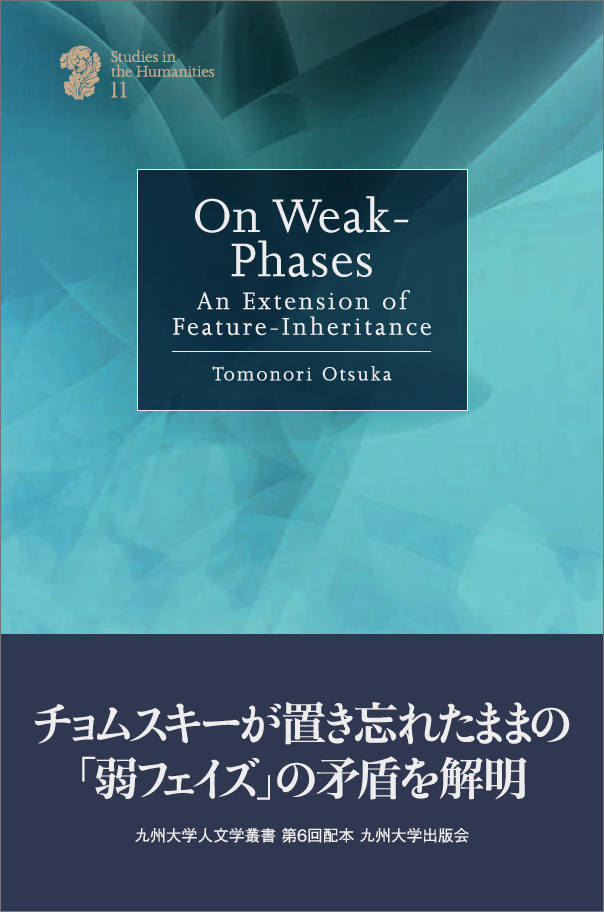On Weak-Phases An Extension of Feature-Inheritance
- シリーズ名
- 九州大学人文学叢書 11
- 著者名
- 大塚知昇
- 価格
- 定価 6,600円(税率10%時の消費税相当額を含む)
- ISBN
- 978-4-7985-0197-0
- 仕様
- 菊判 上製 222頁 C3382
- 発行年
- 2017年1月
- ご注文
内容紹介
本書は、生成文法のミニマリストプログラムにおけるフェイズ理論の理論的問題点を指摘し解決することにより、フェイズ理論のさらなる発展に貢献するものである。
生成文法は、人間の持つ言語機能の本質を見極め人間言語における普遍文法の特性を解明するという目標のもとに進展を続け、現在ミニマリストプログラムと呼ばれる研究局面に至っている。特に2000年代から現在にかけては、文の派生をフェイズという単位ごとに分割するフェイズ理論のもと、更なる革新的な発展が得られてきた。しかしながら、現行のFeature-Inheritanceに基づいたフェイズ理論には、Chomsky (2001)で議論され、その後議論がなされていない弱フェイズに関して、理論的な問題がある。本書ではこの問題点を「弱フェイズの矛盾」と名付け、Chomsky (2008)が提案したFeature-Inheritanceを拡張した「Feature-Transcription」の枠組みのもと、その解決策を示す。
目次
Acknowledgments
1 Introduction
2 Theoretical Background
2.1 Uninterpretable Features and Syntactic Operations
2.2 The Phase Theory
2.3 Feature-Inheritance
2.3.1 Uninterpretable Features and Syntactic Values
2.3.2 A Simultaneity Problem
2.3.3 Richards (2007) and Feature-Inheritance
2.4 A/A-bar Distinctions
2.5 Summary
3 A Proposal
3.1 The Paradox of Weak-Phases
3.1.1 The Existence of a Strong/Weak Distinction in Phases
3.1.2 The Paradox
3.2 Previous Analyses
3.2.1 Chomsky (2001)
3.2.1.1 A Weak-Phase without Transfer
3.2.1.2 Problems with Chomsky (2001)
3.2.2 Richards (2012)
3.2.2.1 A Weak-Phase with Transfer
3.2.2.2 A Theoretical Problem in Richards (2012)
3.3 A Solution to the Paradox of Weak-Phases
3.3.1 A Logical Conclusion of the Paradox of Weak-Phases
3.3.2 An Answer: Everything at a Strong-Phase Level
3.4 A Proposal: Feature-Transcription
3.4.1 A Remaining Theoretical Question
3.4.2 Activation: Feature-Transcription
3.5 Theoretical Consequences
3.5.1 Two Possibilities of Derivations
3.5.2 An Assumption on a Case Assignment Mechanism
3.6 Summary
4 Verbal Weak-Phases
4.1 Infl ection on Passive Participles
4.1.1 Infl ection and Movement
4.1.2 A Previous Analysis: Richards (2012)
4.1.2.1 Richards’ (2012) Analysis
4.1.2.2 Problems in Richards (2012)
4.1.3 An Alternative Account
4.1.3.1 An Explanation of the Infl ection-Movement Connection
4.1.3.2 A Solution to Richards’ (2012) Problems
4.2 Thematization/Extraction
4.2.1 Thematization/Extraction: Chomsky’s (2001) Invention
4.2.2 Richards’ (2012) Approach and his Problem
4.2.3 An Alternative Account under Feature-Transcription
4.3 The Nominative/Accusative Case Conversion in Japanese
4.3.1 Previous Analyses
4.3.2 Further Problems
4.3.3 Takahashi (2011)
4.3.3.1 A Phase-Based Approach
4.3.3.2 Problems in Takahashi (2011)
4.3.4 An Alternative Account under Feature-Transcription
4.4 The Double Object Construction in English
4.4.1 An Overview of Some Analyses of the Double Object Construction
4.4.1.1 VP-shell and vP
4.4.1.2 Are the Two Constructions Related or Not?
4.4.2 Asymmetries between Indirect Object and Direct Object
4.4.2.2 Previous Analyses
4.4.2.2.1 Oba (2005)
4.4.2.2.2 Bruening (2010a)
4.4.3 The Structure of the Double Object Construction
4.4.3.1 Null-P
4.4.3.2 An Applicative Head and an Aspect Head
4.4.3.3 A Structure for the Double Object Construction
4.4.4 A Solution to the Problems
4.4.4.1 The Impossibility of A-Movement of Direct Object
4.4.4.2 The Impossibility of A-Bar Movement of Indirect Object
4.4.4.2.1 On A-Bar Movement of PP
4.4.4.2.2 An Explanation
4.4.4.3 Exceptions
4.5 Summary
5 Clausal Weak-Phases
5.1 The ECM Construction in an Irish Dialect of English
5.1.1 Does the ECM Construction Include TP or CP?
5.1.2 McCloskey (2000)
5.1.3 A Solution
5.2 The Japanese Raising-to-Object Construction
5.2.1 Another Case Conversion in Japanese
5.2.2 Previous Analyses
5.2.3 An Alternative under Feature-Transcription
5.3 Complementizer Agreement in West Flemish
5.3.1 A Puzzle of Complementizer Agreement
5.3.2 Haegeman and Koppen (2012)
5.3.3 A Possible Solution
5.4 Summary
6 Prepositional Weak-Phases
6.1 Prepositional Phases
6.1.1 A Strong-Phase p*P
6.1.2 A Weak-Phase pP
6.2 Adjunct Islands
6.2.1 Previous Analysis
6.2.2 The Labeling Algorithm
6.2.3 A Consideration on Modifi cation Relations in Syntax
6.2.3.1 Previous Analysis
6.2.3.2 Lexical Edge Features
6.2.4 Adjunct Islands
6.3 Preposition-Stranding/Pied-Piping
6.4 Preposition-Stranding in Rightward Movement
6.5 A Consideration on Edge Features
6.5.1 The Nature of “Normal” Edge Features
6.5.2 The Nature of Lexical Edge Features
6.5.3 Deriving Lexical Edge Features from θ-Role Features
6.5.4 On Phasal Edge Features and the Whole Framework in this Book
6.6 Summary
7 Concluding Remarks
References
Index
著者紹介
大塚知昇(おおつか とものり)
1988年福岡県福岡市、博多生まれ。博士(文学、九州大学)。
専門は生成文法、二重目的語構文や格に関する研究およびミニマリストプログラムの理論研究。
九州大学専門研究員を経て、現在、九州共立大学、共通教育センター、講師。









